The American Southwest is a treasure trove of ancient art etched onto the canvas of the desert landscape. As you journey through this region, you have the unique opportunity to connect with the past by visiting sites adorned with petroglyphs and pictographs.
This adventure offers more than a journey through history. It immerses you in an experience that deepens your understanding of the link between art, nature, and human life.
We even added a map with a suggested route connecting all 20 locations into a marvelous road trip!
1. Valley Of Fire State Park
Starting at stop #1, we have a treasure trove of prehistoric art and stunning landscapes of bright red Aztec sandstone outcrops — the Valley Of Fire State Park.
A short drive from Las Vegas unveils the Valley Of Fire's ancient narratives, where petroglyphs over 2,000 years old tell stories of survival and spirituality amidst fiery red sandstone.
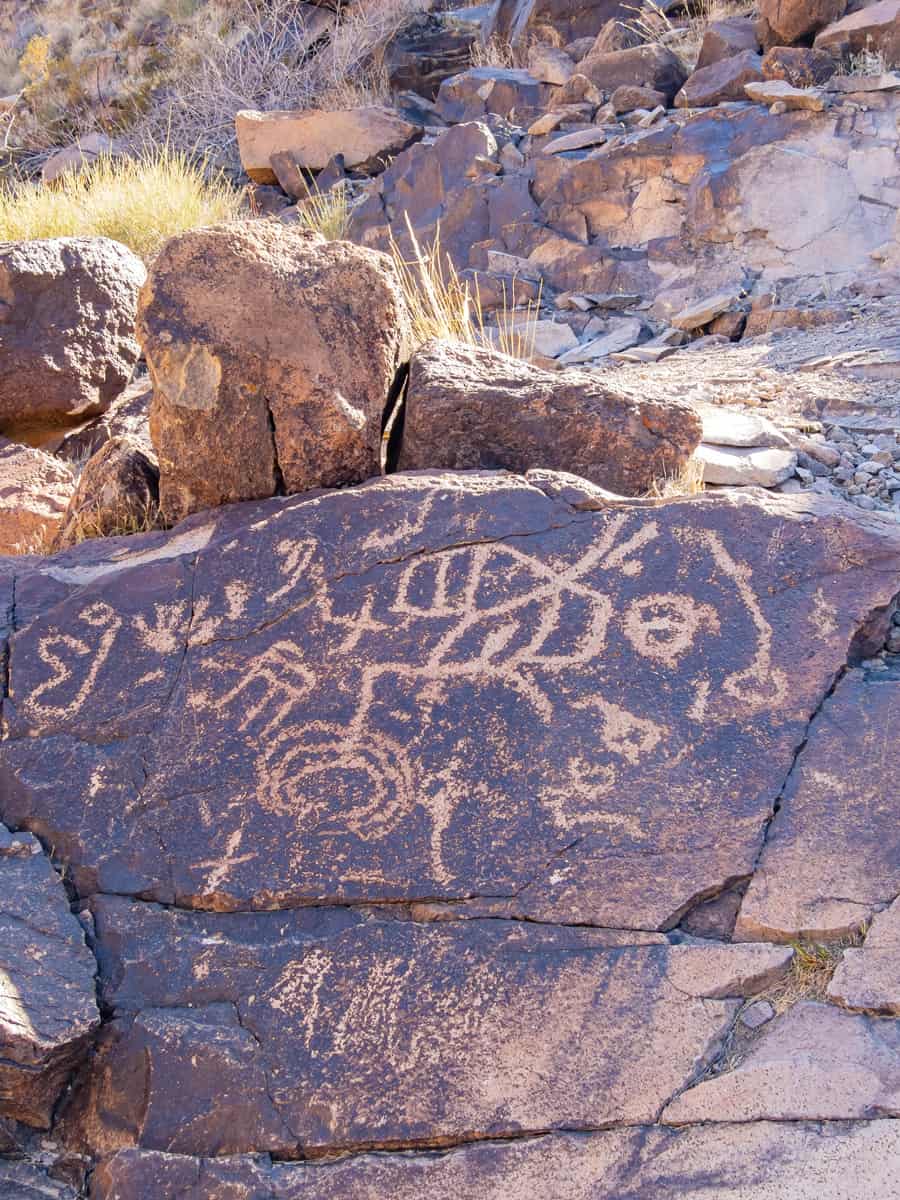
These works of art can be found in several locations within the park, most notably at Atlatl Rock and along the Mouse's Tank Trail, also known as Petroglyph Canyon Trail.
There's a small entrance fee, depending on where you're from, but it's totally worth the experience.
You don't need to be a hardcore hiker to enjoy the petroglyphs; the walks are easy and short. Just make sure to bring water, especially if it's hot.
2. Little Black Mountain Petroglyphs Site
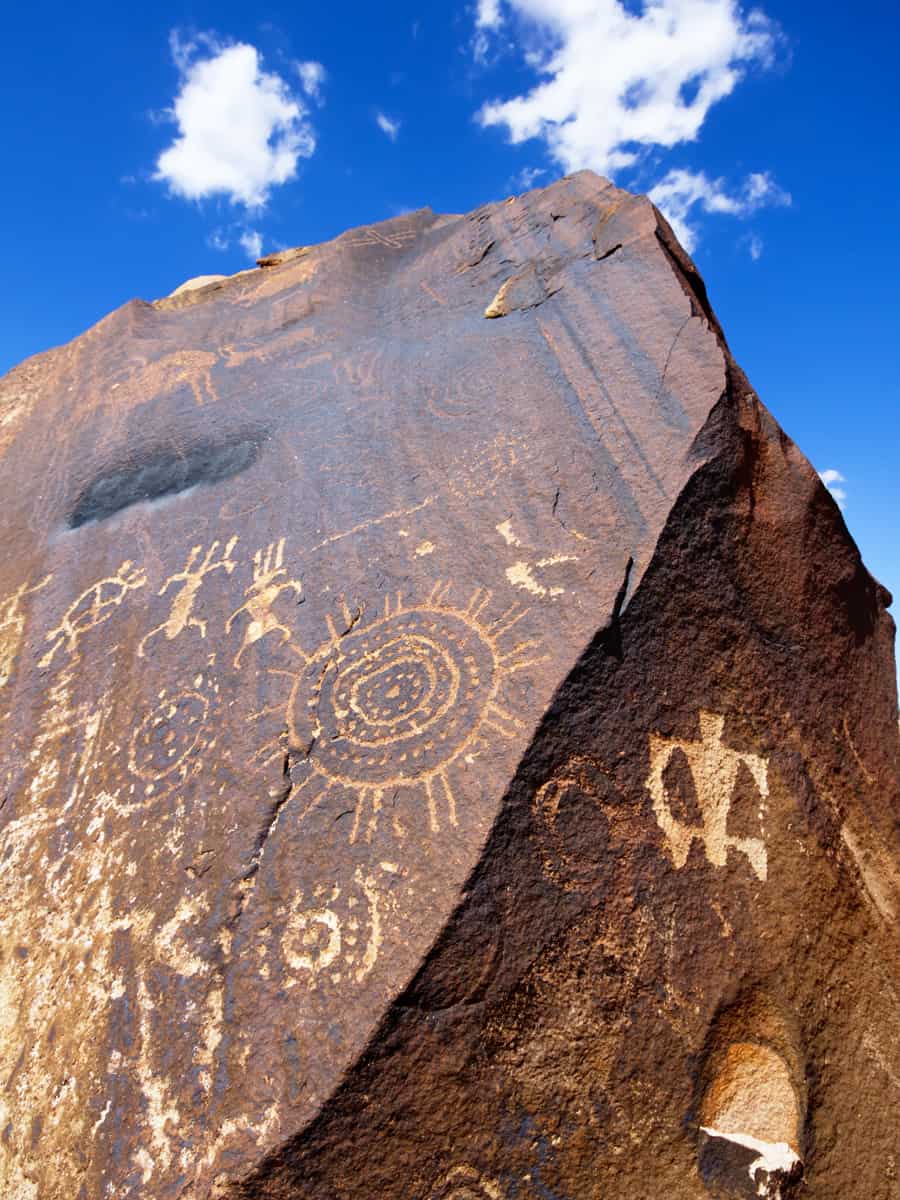
Next up is the Little Black Mountain Petroglyphs Site! An easy-to-walk 0.8-mile out-and-back trail with a minor elevation gain of 49 feet stands between you and these ancient artworks.
Typically, it takes about 16 minutes to complete, making it suitable for all ages and fitness levels.
The site presents over 500 petroglyphs, with some dating back to 6,000 years. They're thought to be the creative works of the Ancestral Puebloans and offer profound insight into their daily lives and beliefs.
As you explore, you'll wander around large sandstone boulders adorned with these mysterious symbols, all under the impressive backdrop of Little Black Mountain.
3. Parowan Gap Petroglyphs
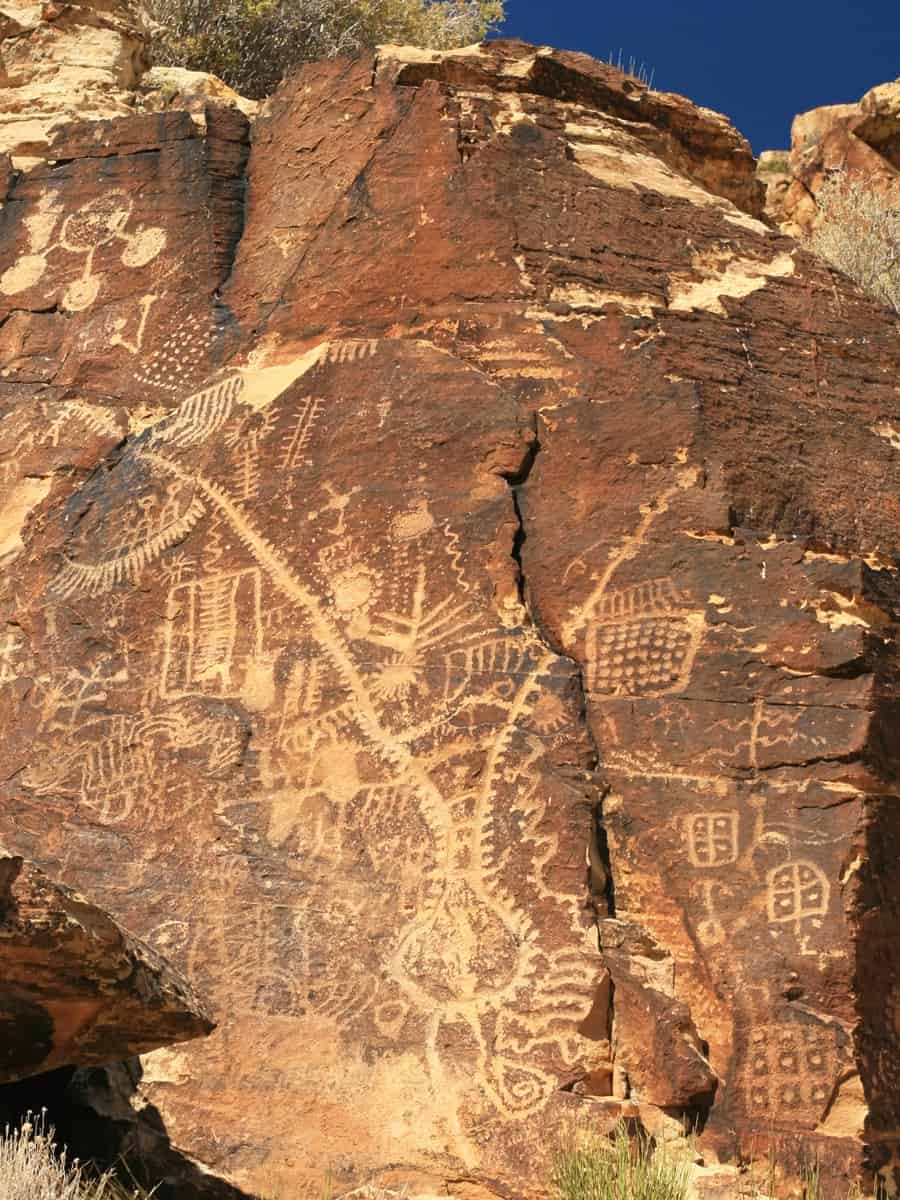
Listed on the National Register of Historic Places, the Parowan Gap boasts an extensive collection of carvings.
The art includes various figures, from animals and humans to abstract shapes like circles, spirals, lines, and dots.
Some of the petroglyphs, like the notable "Zipper" glyph, are thought to be quite complex, possibly representing maps, calendars, or solar alignments.
If you're coming from Cedar City, it's just a drive north and then a short hop east on a gravel road.
No hiking boots are required — you can see many petroglyphs right from the road. Plus, no entrance fee or permits are needed, so it's a perfect spur-of-the-moment adventure!
4. Fremont Indian State Park
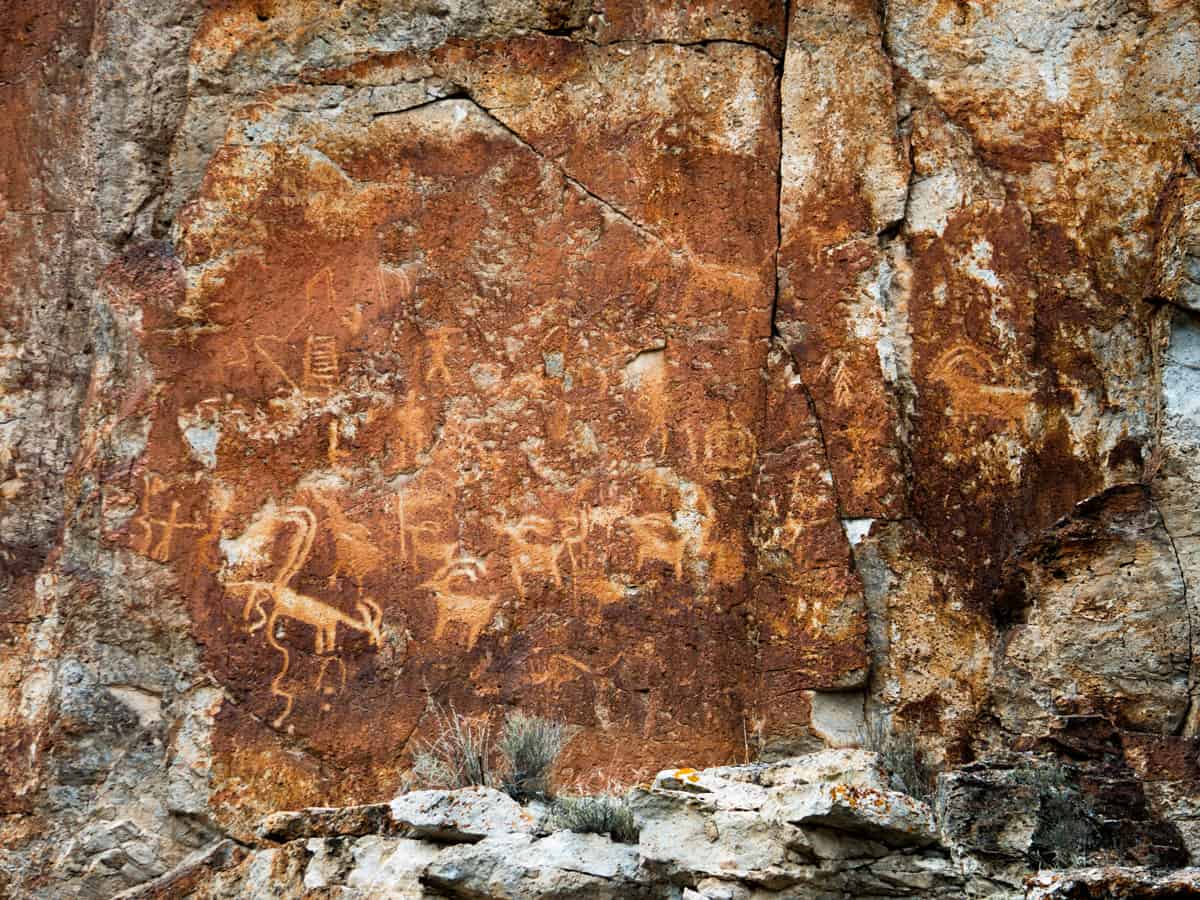
This site was discovered during the construction of Interstate 70 in 1983, which uncovered the largest known Fremont Indian village.
Now, it's a place where you can walk trails like the Parade of Rock Art to check out these ancient doodles up close.
The park isn't just about history; it's also set in a beautiful canyon with neat volcanic rock formations perfect for geology buffs.
Plus, it has many easy trails that are perfect for a quick hike to see the art and nature. It's a bit of a drive from Salt Lake City, but it's worth it for the cool sights and a bit of stargazing at night since it's an official Dark Sky Park.
Extend your stay by setting up at one of the 38 individual RV and tent camping sites. Enjoy nature's solitude and spend more time with the ancients' artistry.
Check out the Utah State Parks page for more insights and details on planning your visit.
5. Buckhorn Wash Pictograph Panel
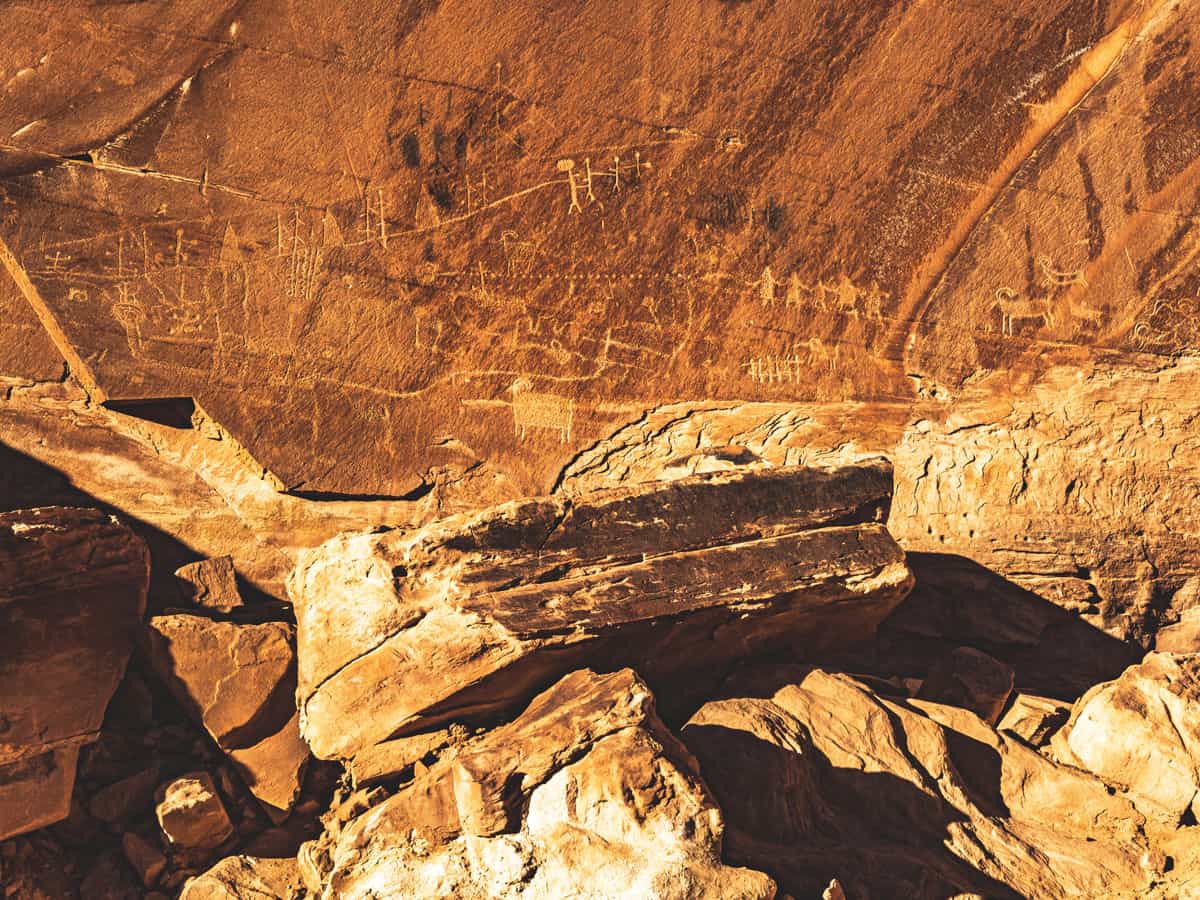
Here, you'll find both pictographs and petroglyphs created by the Barrier Canyon culture, dating from the Late Archaic Period, around 2000 BCE to 500 CE.
These petroglyphs and pictographs are renowned for their vivid depictions of ghostly humanoid figures and animals, characterized by their lack of arms and legs and elaborate decorations.
Accessing the panel is straightforward, with a drive-through of the beautiful Buckhorn Wash.
No hiking is required to reach the site, and no entrance fees or permits are needed, making it an easy glimpse into ancient art and spirituality.
6. Newspaper Rock State Historic Monument
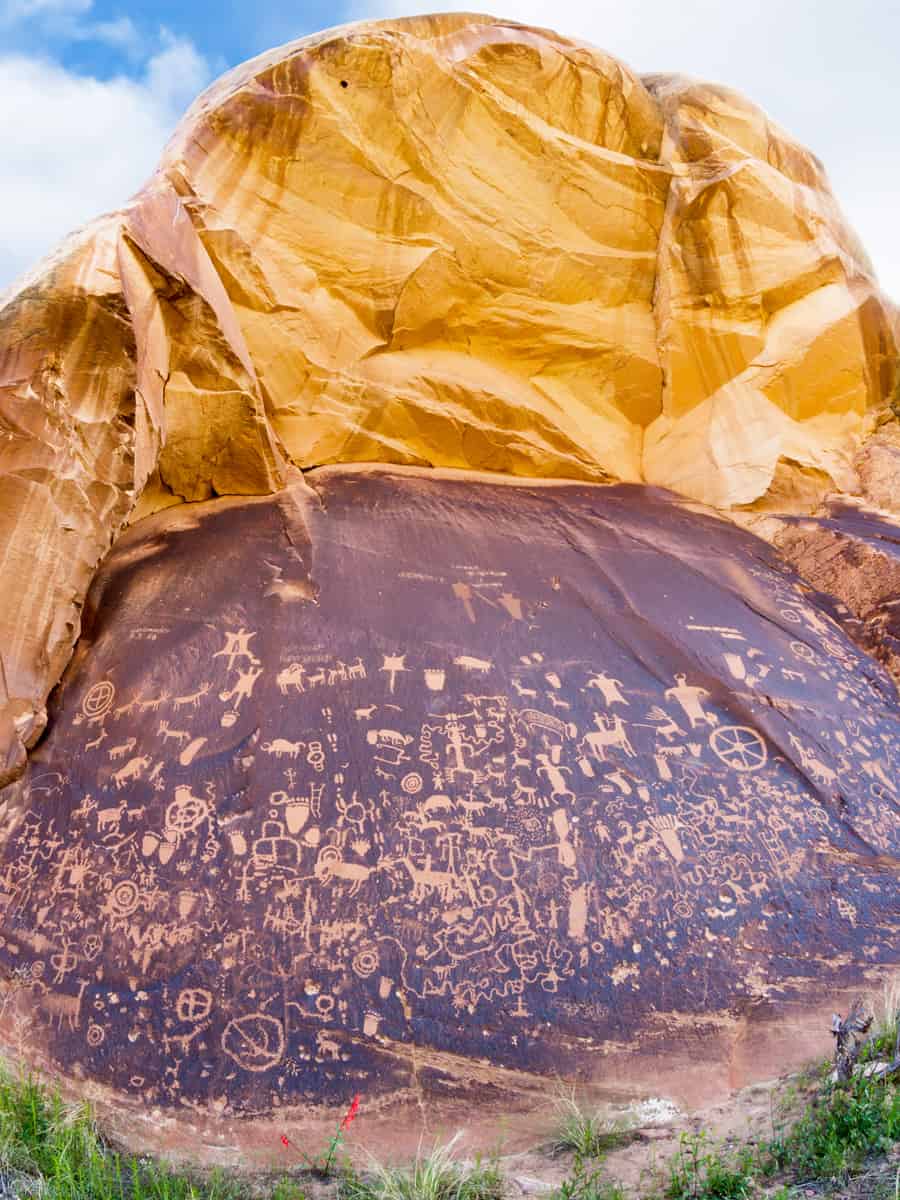
Not to be confused with the one from Petrified Forest National Park (which we'll cover later), Newspaper Rock State Historic Monument in Utah is a real treasure trove of ancient stories etched in stone.
This historic site features rock art spanning over 2,000 years, created by ancient cultures, including the Puebloan people and the Ute tribe.
One of the most fascinating details is that some figures show polydactyly – extra fingers or toes – suggesting these artists were keen observers of the human condition.
There's no entry fee to drop by and dive into this slice of history. It also has ample paved parking with spaces for larger vehicles and RVs.
7. Navajo National Monument
This site features ancient petroglyphs and pictographs created by the Ancestral Puebloan people, who lived here from about 500 to 1300 CE.
The rock carvings and paintings include a range of symbols, from abstract designs to representations of animals and humans, reflecting the culture, beliefs, and daily life of these ancient communities.
The site offers free entry and self-guided trails like the Sandal, Aspen, and Canyon View Trail, leading to historical views. Ranger-led tours provide deeper insights into Betatakin and Keet Seel.
8. Canyon De Chelly National Monument
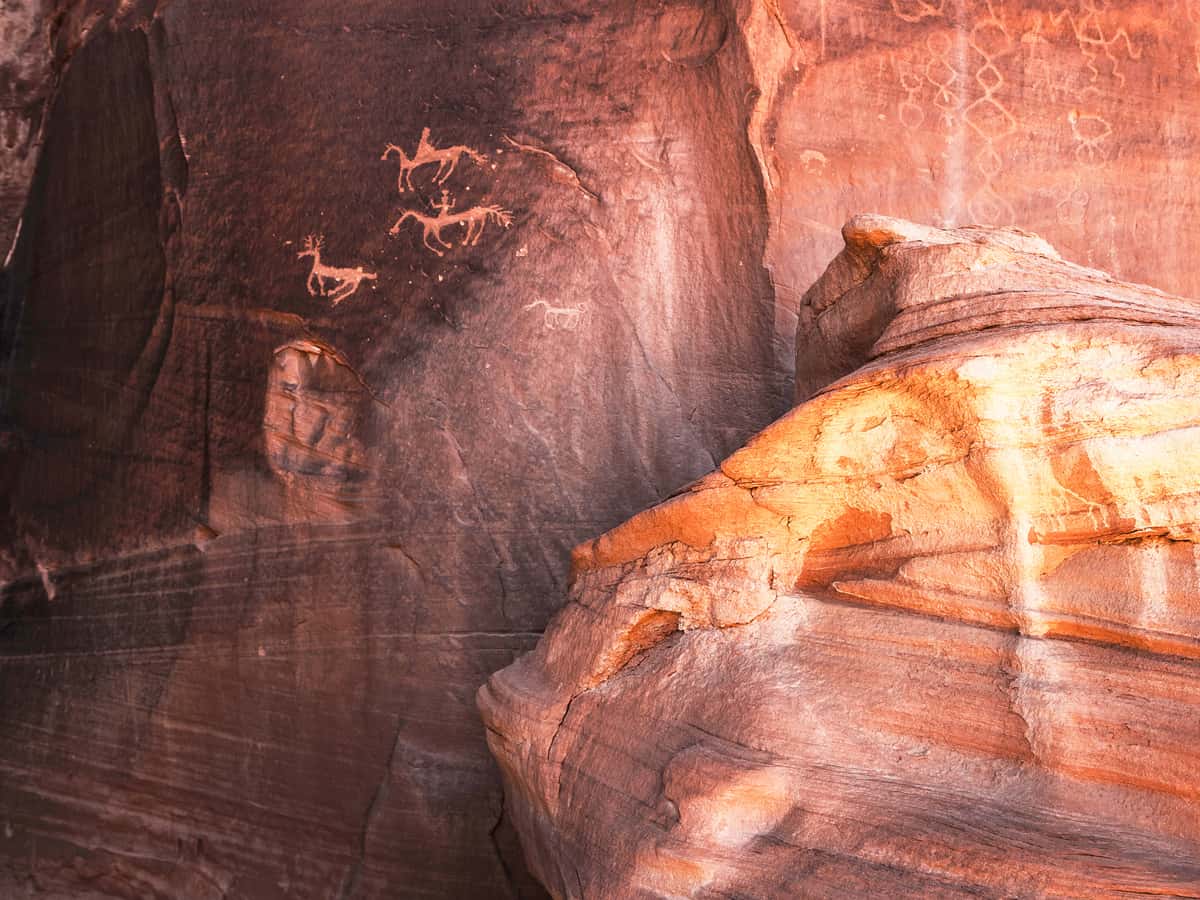
The petroglyphs and pictographs at Canyon de Chelly offer a visual narrative of the Native American presence in the region, stretching back over 5,000 years, including interactions with Europeans.
For example, one pictograph was said to possibly represent a Navajo depiction of Spaniards from a battle in 1805, emphasizing complex Navajo-European relations.
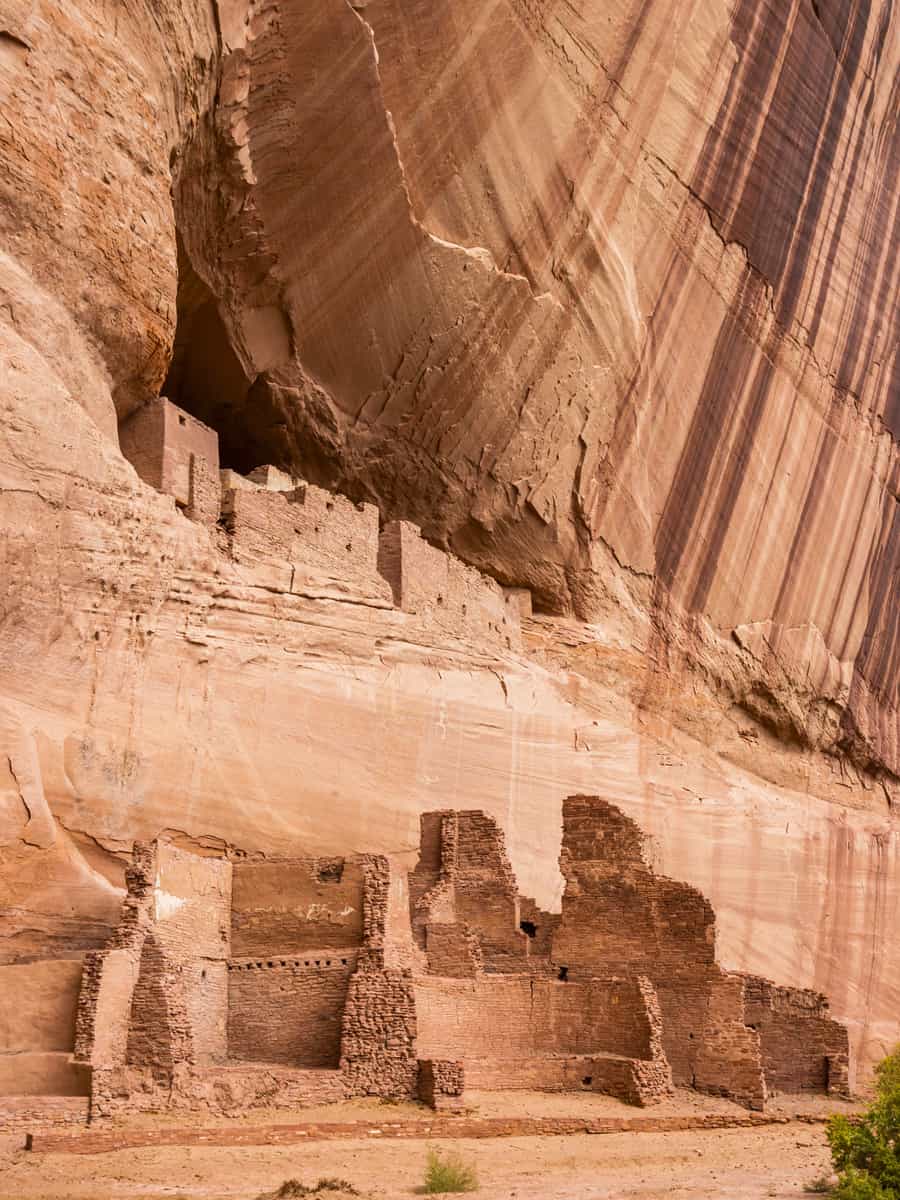
One of the coolest spots to see is the White House Ruins — it's built right into the cliffside and shows off how smart and organized the Ancestral Puebloans were when building their homes.
You can take private tours with Navajo guides who know all the stories and history. One on TripAdvisor offers around $250 for a 3-hour private tour with great reviews from hundreds of people.
But of course, choosing companies endorsed by the Navajo Parks and Recreation Department is recommended for authenticity and respect.
They'll take you to the critical spots, like those amazing cliff dwellings, and explain the meanings behind those old rock drawings.
9. Mesa Verde National Park
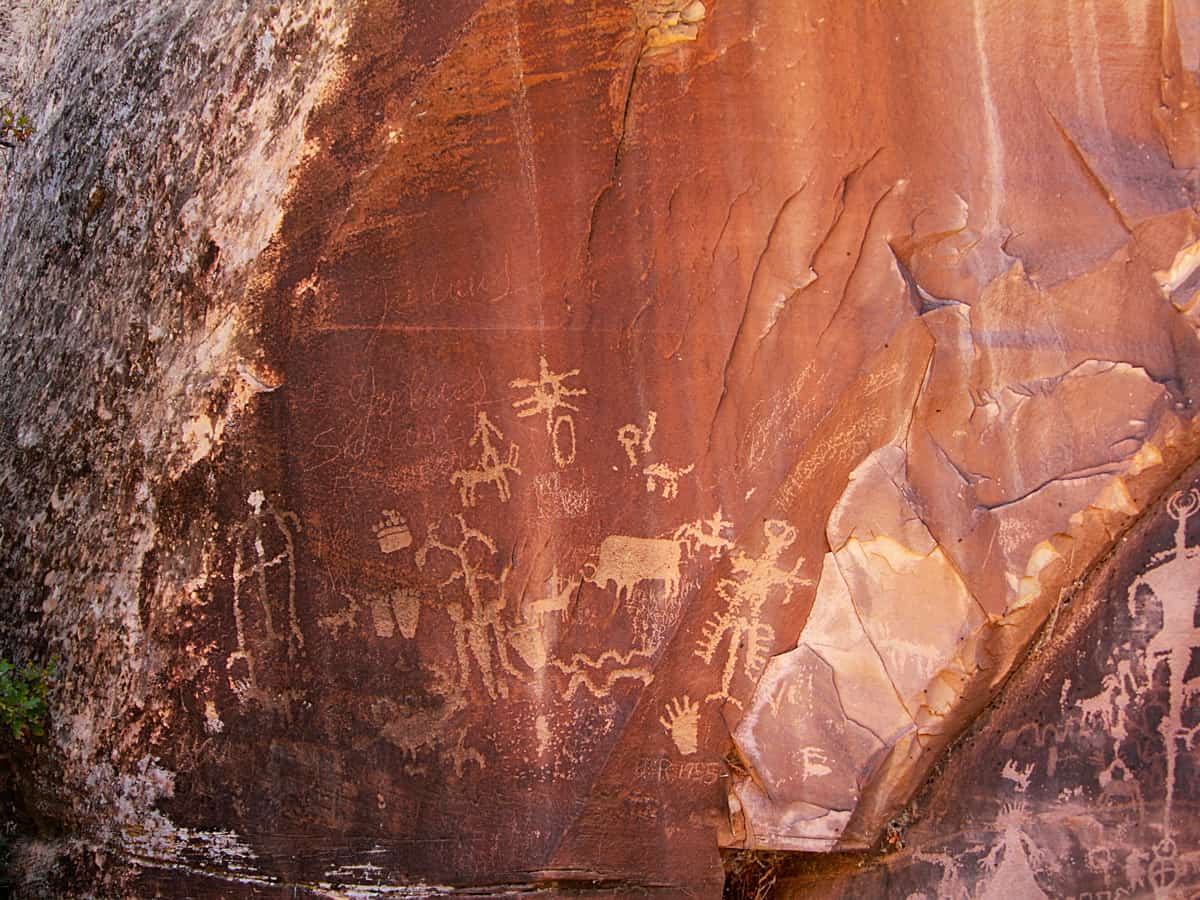
For a direct view of ancient petroglyphs at Mesa Verde, go to the Petroglyph Point Trail.
This trail isn't just a walk in the park—it's a 2.4-mile adventure offering spectacular canyon views and intriguing rock carvings created by the Ancestral Puebloans.
Expect uneven and rocky paths, so you must wear sturdy shoes. This park requires an entrance fee, with winter rates usually cheaper from November 1 to April 30.
At this site, you'll see images pecked into the rock that potentially narrate the stories of ancient peoples. A prominent panel showcases a boxy spiral shape, said to be a symbolic representation relating to the Hopi culture.
10. Chaco Culture National Historical Park
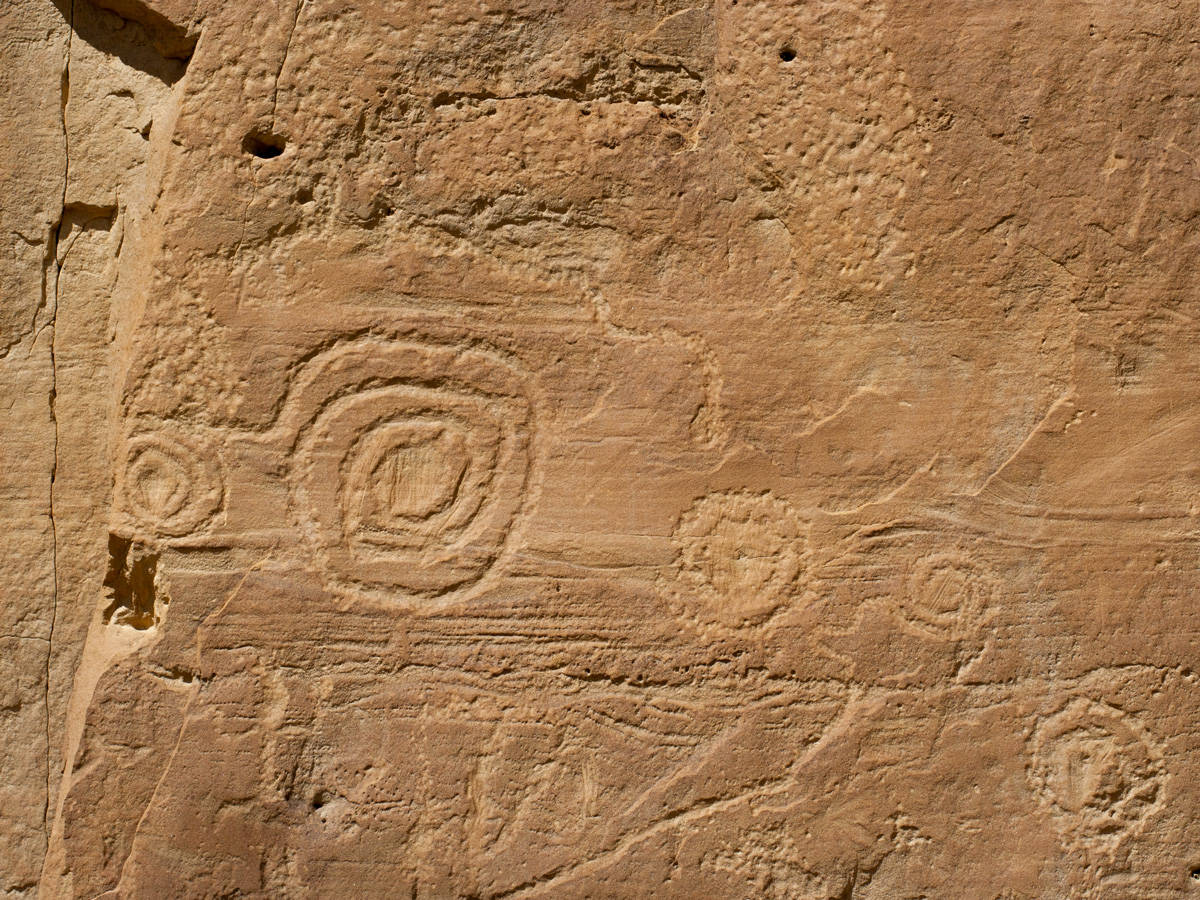
Here, you'll find intriguing designs like spirals and figures, often linked to the cosmos and seasonal cycles, that hold deep meanings to the Pueblos that thrived here between 850 and 1250 CE.
One of the highlights is the Petroglyph Trail, a short 1/4 mile where you can see these carvings up close — some are high on the cliffs, making you wonder about the lengths the Chacoans went to create them.
Petroglyphs that may depict a solar eclipse from 1097 and a pictograph possibly showing the supernova of 1054 are evident, highlighting their understanding of astronomy.
For a hassle-free visit to Chaco Culture National Historical Park, consider buying a Site Pass in advance, valid only for a week.
11. Bandelier National Monument
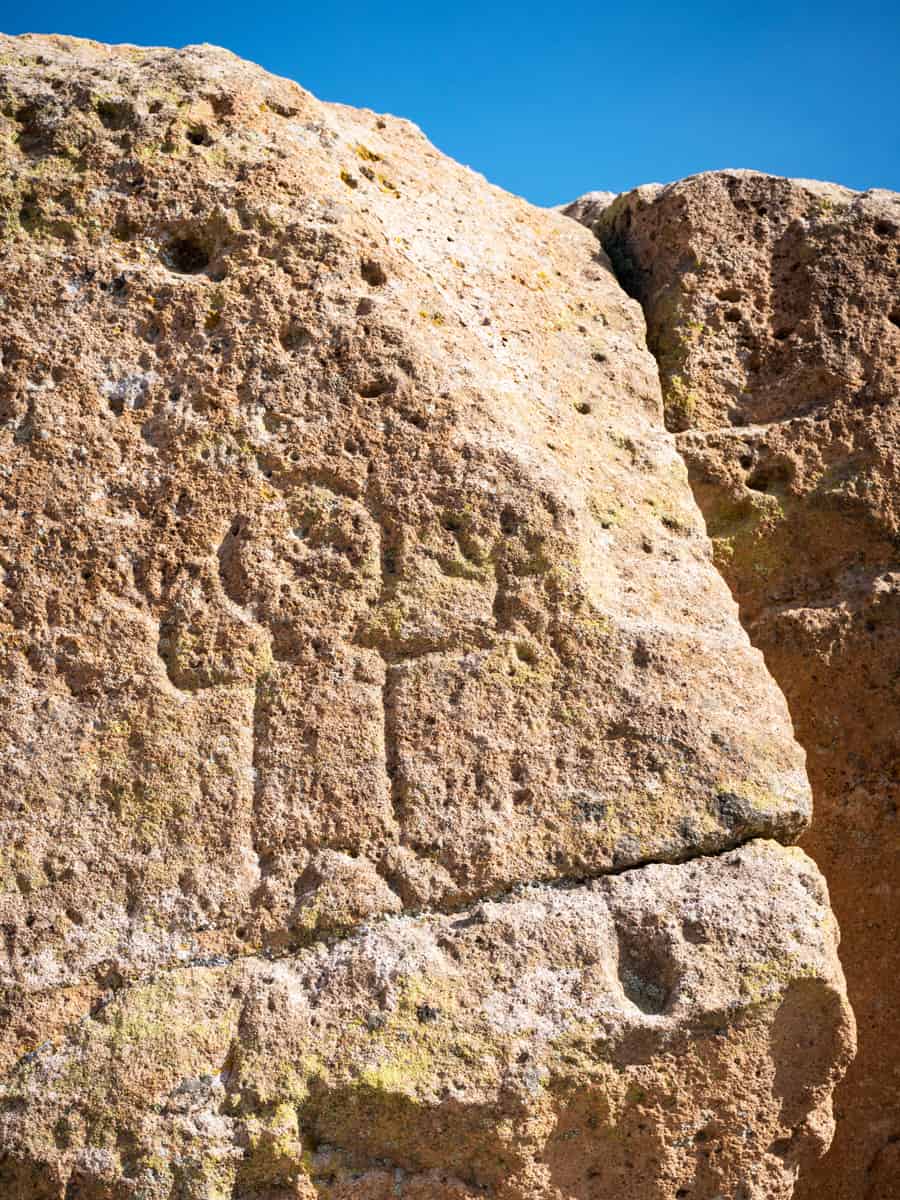
One notable petroglyph you might spot as you explore Bandelier is a turkey carving found on the Main Pueblo Loop Trail.
These rock carvings and painted pictographs are scattered throughout the monument, each telling a story of the area's past inhabitants and their connection to the land.
To dive into this history, you need to do a bit of hiking. Trails like the one at Tsankawi, with its 1.5-mile walk featuring ladders and exposed paths, lead you past old village sites and more petroglyphs.
These sites are precious and fragile, so tread lightly and respect the signs and barriers. Before heading out, checking the latest entrance fees or permits through this page is a good idea.
12. La Cieneguilla Petroglyph Site
This site is home to hundreds of petroglyphs dating back to pre-contact times and the Spanish colonial era, which include notable images of Kokopelli, the flute-playing fertility deity, and over a thousand bird figures.
Access to the site is relatively straightforward, involving an easy hike suitable for most visitors.
The journey begins at a designated parking area, leading to the base of the basalt cliffs adorned with petroglyphs in about five to ten minutes.
Best of all, you can embark on this journey of discovery without worrying about entrance fees, as visiting the La Cieneguilla Petroglyph Site is completely free.
13. Petroglyph National Monument
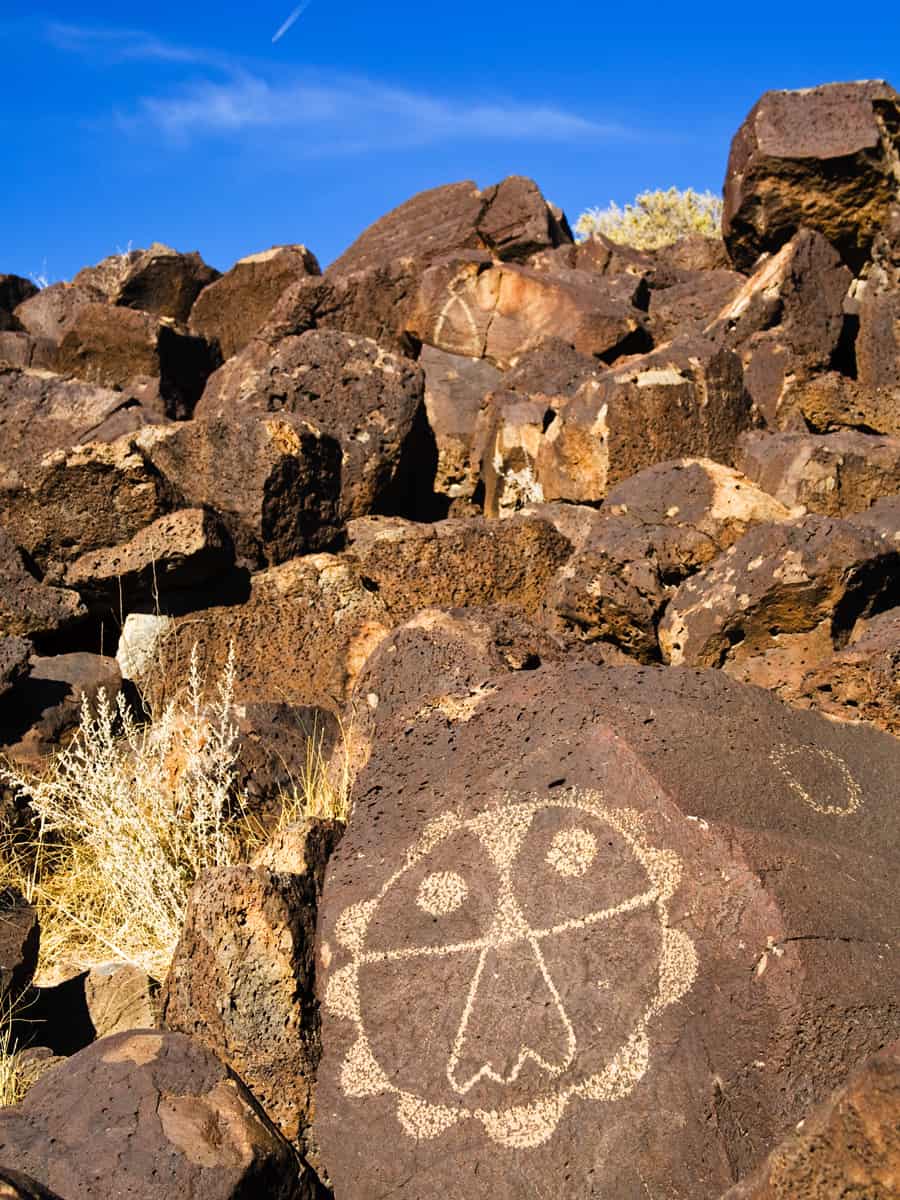
The Petroglyph National Monument preserves one of the largest petroglyph sites in North America, showcasing the cultural expression of Native Americans and Spanish settlers from 400 to 700 years ago.
An estimated 25,000 petroglyph images along a 17-mile volcanic rock escarpment offer a unique window into the cultural expressions and spiritual beliefs of today's ancestors of today's Pueblo people.
To see these carvings closely, you can wander through Boca Negra, Rinconada, and Piedras Marcadas Canyons. Each spot has its own set of petroglyphs you can see right from the trails.
Boca Negra offers a quick stroll to spot around 100 carvings. If you're up for more walking, Rinconada's loop trail is 2.2 miles long and shows off about 300 petroglyphs.
For a middle ground, Piedras Marcadas gives you a 1.5-mile round trip with around 400 petroglyphs to discover. Getting into the monument is free, though parking at Boca Negra comes with a small fee.
14. El Morro National Monument
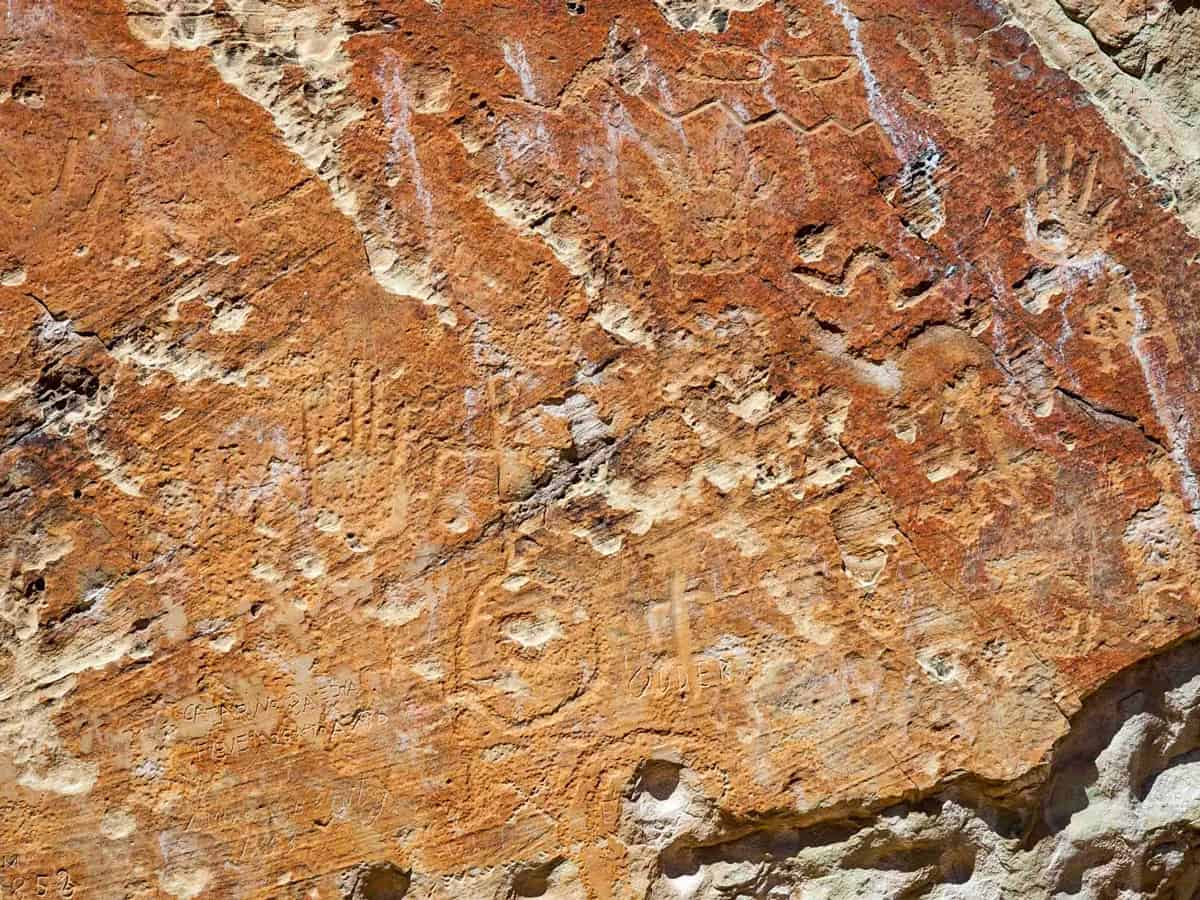
El Morro National Monument, also known as Inscription Rock, is a place where history is literally written in stone.
Starting with the Ancestral Puebloans in the 1200s to Spanish explorers like Don Juan de Oñate in 1605, and later American pioneers, each group has left its mark on this natural canvas.
As you explore, you'll notice that El Morro has served as a canvas for travelers over the centuries.
The inscriptions, dating back over two centuries, often start with "paso por aqui," (passed through here) followed by the traveler's name and date, providing a record of the region's exploration and settlement.
Today, you can walk in the footsteps of these diverse cultures via trails like the Inscription Rock Trail and the Headland Trail.
With no entrance fee and accessible trails, El Morro offers you a fascinating, tangible connection to the past, nestled in the high desert landscape of New Mexico.
15. Petrified Forest National Park
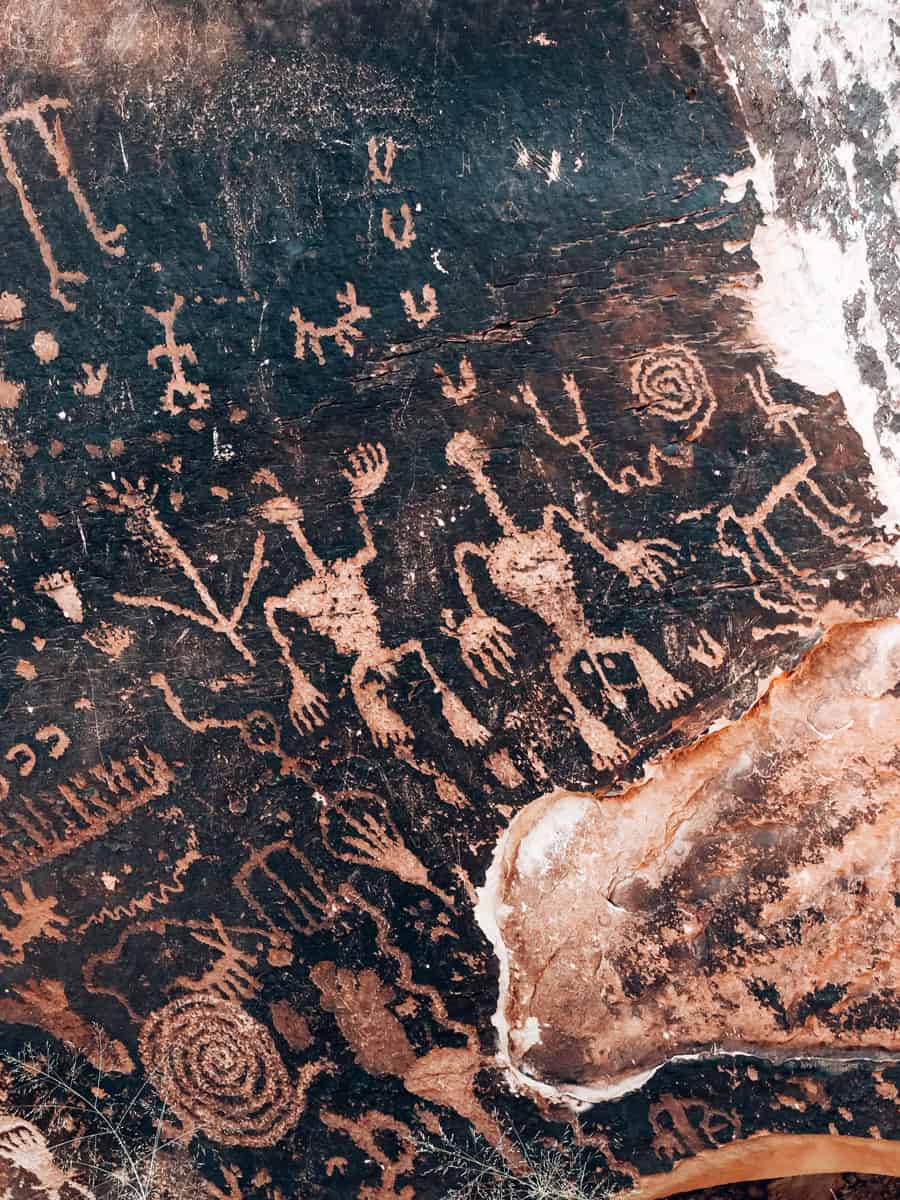
At Petrified Forest National Park, you'll find a rich history etched into stone. Start your exploration at Newspaper Rock, where over 650 petroglyphs showcase stories from the past.
Located near mile marker 12, this site provides views from an overlook, so be sure to bring binoculars for a closer examination—or else you'll have to wait in line for the scope!
A short distance away, near mile marker 11, is Puerco Pueblo, offering a glimpse into the lives of ancient inhabitants through more than 800 petroglyphs surrounding the ruins of a Puebloan village.
The park also features attractions like the Crystal Forest and Jasper Forest Overlook, adding to its appeal with natural beauty and historical depth.
If you're really into adventure, the park lets you go backpacking in the Petrified Forest National Wilderness Area.
But unlike conventional camping, the park does not offer RV, car, or front-country camping; instead, you'll need to hike at least a half-mile from any vehicle to camp under the stars amidst the ancient landscape.
If you're looking for a day visit, you must pay entrance fees, which can depend on your vehicle type.
16. Three Rivers Petroglyph Site
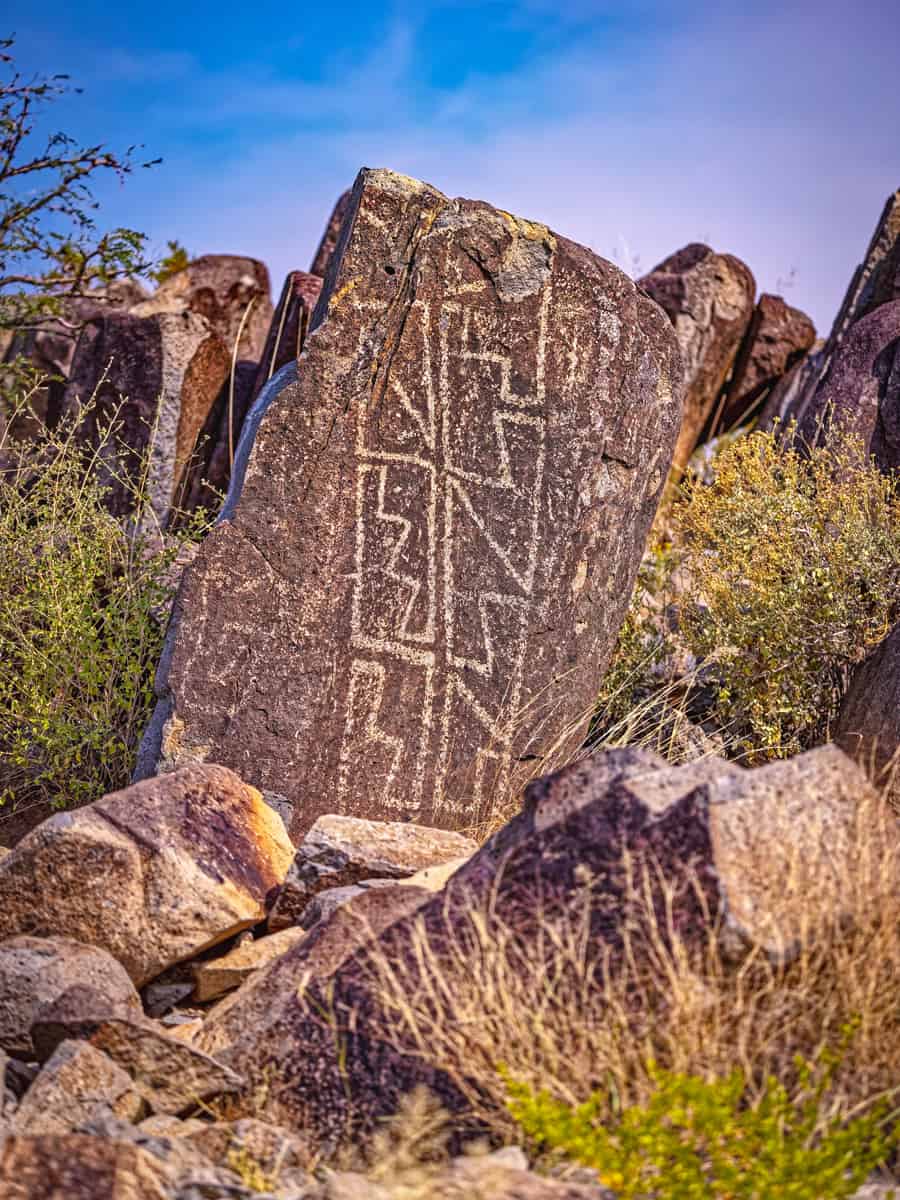
This remarkable repository of ancient Jornada Mogollon rock ark has over 21,000 petroglyphs etched into a basaltic ridge rising above the Three Rivers Valley.
The site offers a rugged 0.5-mile trail starting at the visitor shelter, linking many of the most captivating petroglyphs.
There's also a short trail leading to a partially excavated prehistoric village, offering a glimpse into the daily lives of its creators.
The site is open year-round, with day-use and camping fees applied and additional fees for RV hookups and group sites.
17. Hueco Tanks State Park
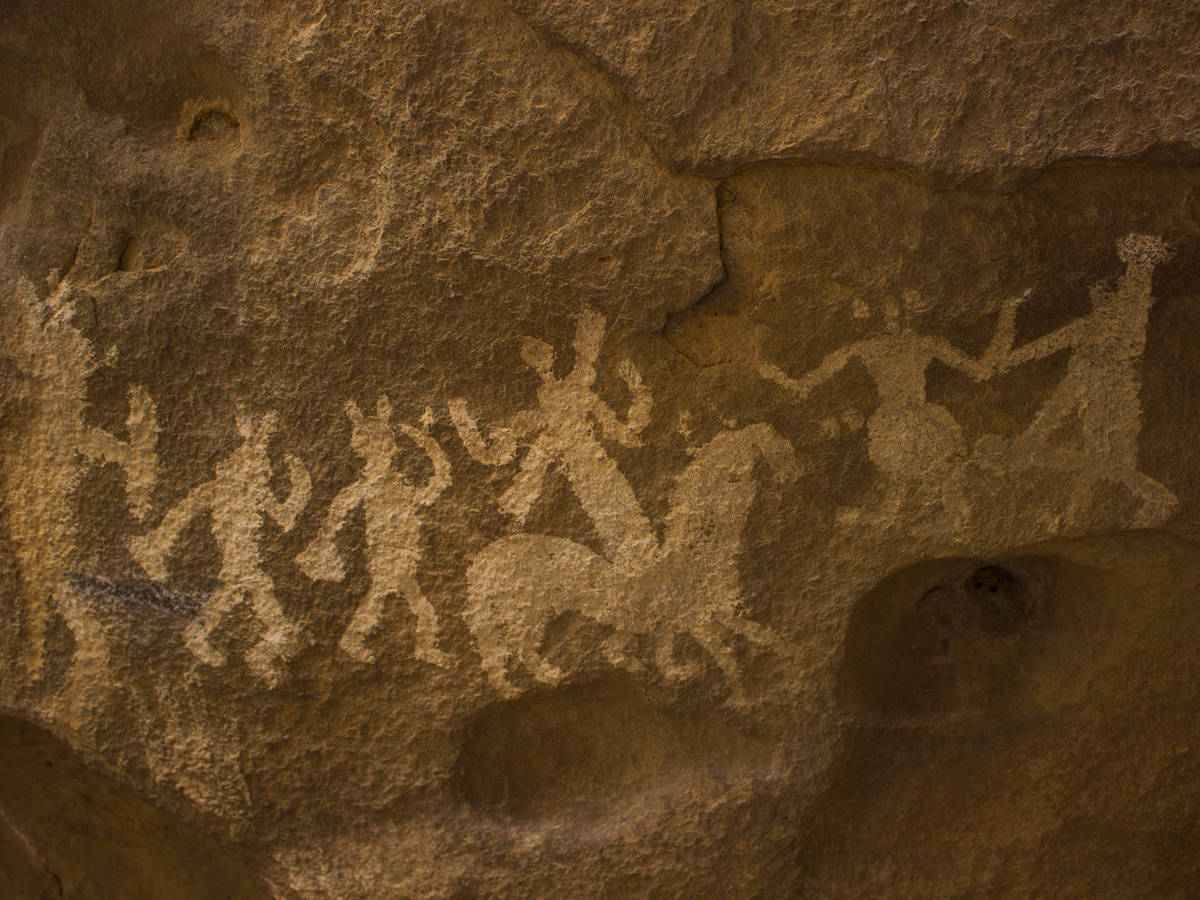
While this park is known as a haven for climbers and hikers, it's also a key destination for seeing ancient petroglyphs.
The art at Hueco Tanks is attributed to several cultures, including the Desert Archaic people, the Jornada Mogollon, and tribes such as the Kiowa, Mescalero Apache, Comanche, and Tigua.
The park's rock art spans from geometric designs and hunting scenes etched by early hunter-gatherers to complex ceremonial masks and deities painted by the Jornada Mogollon people.
Given the site's cultural and ecological sensitivity, we recommend planning ahead and possibly reserving a permit in advance, especially if you're aiming for a guided tour to access restricted areas.
18. Gila Cliff Dwellings National Monument
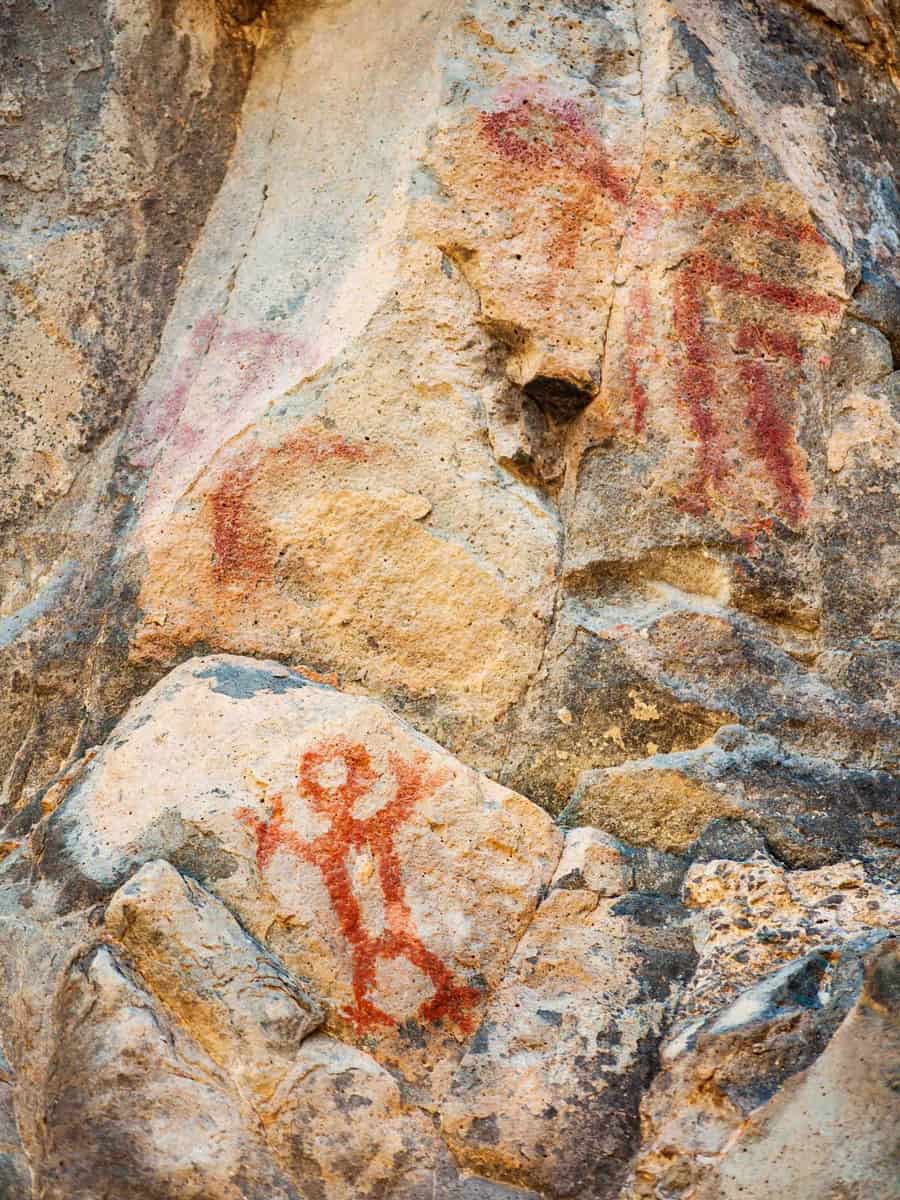
Coming in #18, we have the Gila Cliff Dwellings National Monument!
Nestled in the Gila Wilderness, these remarkable cave dwellings were home to the Mogollon people from the late 1200s through the early 1300s.
Here, you'll see a range of pictographs and petroglyphs that illustrate the Mogollon people's rich cultural tapestry that portrays their daily lives, spiritual beliefs, and the natural world around them.
Located 44 miles north of Silver City, the journey involves a scenic but winding drive requiring 1.5 to 2 hours. You'll also have to prepare for a moderately strenuous hike to reach the dwellings, spanning a one-mile round trip that can take between 1 and 2 hours to complete.
The site is open to all, as there's no need for reservations or entrance fees for the cliff dwellings or the campground.
19. Painted Rock Petroglyph Site And Campground
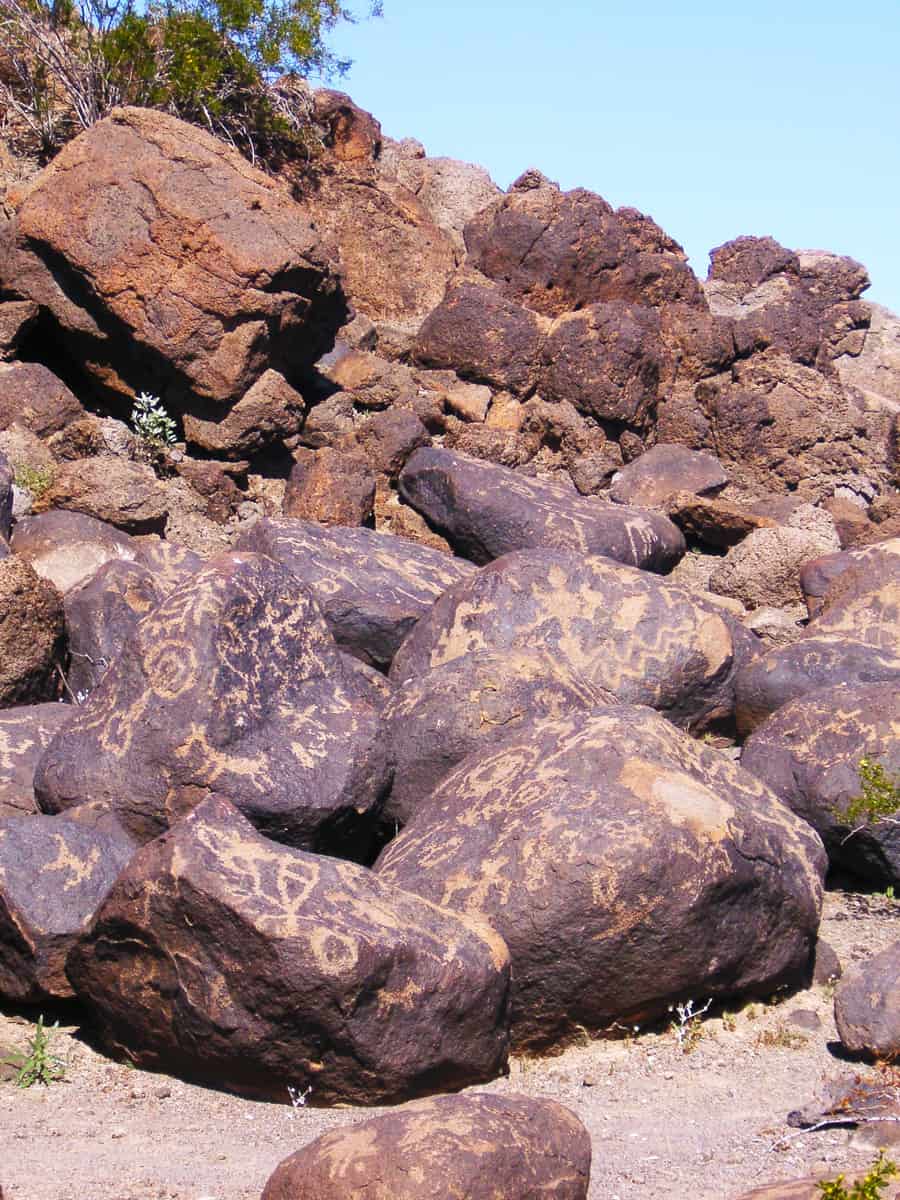
Located about 90 miles southwest of Phoenix, Arizona, this site houses numerous petroglyphs etched by the ancestors of today's Piipaash, O'odham, and Yavapai communities.
The petroglyphs are easily reached from the parking lot, so you don't have to worry about a long hike. The trail to view these remarkable carvings is short and user-friendly, even for beginner hikers.
They have an entry fee, but it's pretty affordable — you can pay in cash or by check. They also have RV and tent camping amenities, which you can make reservations here.
Last reported by campers in 2023, the campground accommodated a 40-foot class A RV, so your larger setups should fit just fine.
20. Deer Valley Petroglyph Preserve
Last but not definitely not least, we have the Deer Valley National Preserve.
With over 1,500 petroglyphs adorning around 500 basalt boulders, the preserve shelters on this site offer a remarkable canvas of history left by the Hohokam, Patayan, and Archaic peoples, who lived in the area from as far back as 500 and 5,000 years.
As you walk the quarter-mile trail in the preserve, you'll see these incredible artworks up close. The trail is easy to walk and even lets you enjoy the Sonoran Desert's native flora and fauna, along with the petroglyphs.
The last entry into the preserve is at 1:30 p.m., with an average visit taking around 45 minutes to fully enjoy the petroglyphs and the natural surroundings.
The self-guided trail allows you to explore at your own pace within this time frame. Admission fees are required for general entry, with discounts available for seniors and children.
Parking is available on-site, and the preserve accepts various forms of payment, including cash, checks made out to Arizona State University, and credit cards.
Carry the Stories of the Southwest's Ancient Artworks, But Leave No Trace Behind!
Exploring the Southwest's petroglyphs and pictographs is like stepping into a vast open-air gallery, where each piece uncouples you from the present and threads you into the rich tapestry of history.
Here's a suggested route that would take you through all of the places we mentioned -
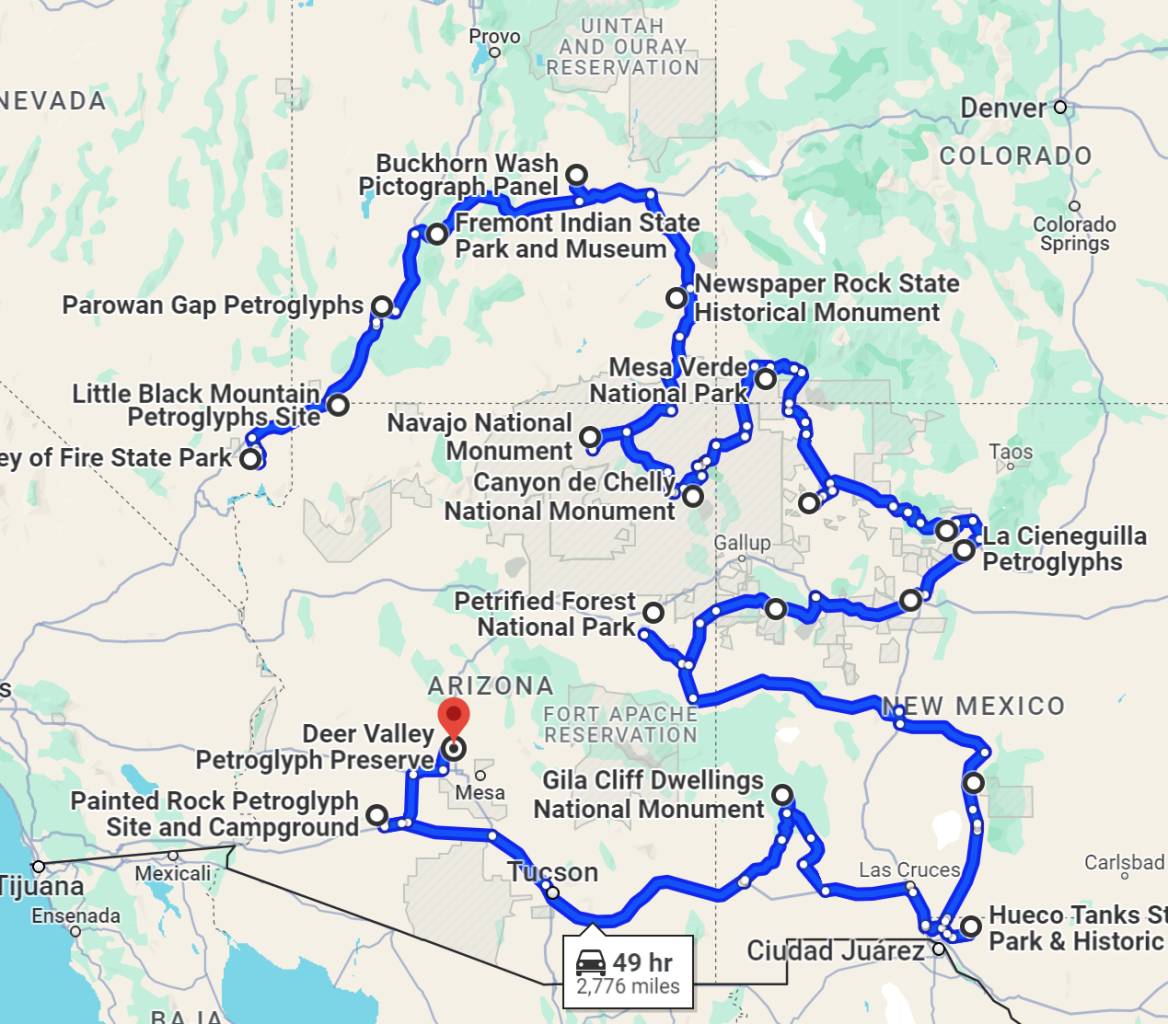
Here's a link to the Google Map
The map above assumes your journey begins in Las Vegas and ends in Phoenoix, AZ, but those points are not included in the route (simply because Google Maps' limit on points connected in a single map!)
Please remember to check specific routes and plan your own trip.
If you want to add something more unique, this Utah National Monument with Dinosaur Fossils And Petroglyphs might be the perfect addition to your travel itinerary.
These ancient artworks are not just attractions but profound storytellers whispering tales of the Indigenous people who once flourished here.
- Respect the Sites: Remember, these are sacred places. Treat each site with the reverence it deserves.
- Take Photos, Leave No Trace: Capture memories on your camera, but ensure you leave the area as pristine as you found it.
- Plan Your Visit: Many sites are remote. So be sure you're well prepared with directions, supplies, and knowledge of local regulations.
Your journey through these historical landmarks is both a privilege and a responsibility.
As you traverse from one site to the next, each carved rock and painted wall presents a unique opportunity to connect with the ancients.
Embrace these moments with curiosity and gratitude, and carry the stories of the Southwest's vast landscapes.

Sure would have been nice if this page had included the locations! Most descriptions don’t even mention what state the parks are located in. smh
Hi Just you 😉 The article does include the locations. All you need to do is type them into your favorite maps app (Google Maps, Waze etc) and your GPS will take you there. Thank you for your feedback re the state, but keep in mind that the locations are all in the Southwest so we’re talking a pretty large region and you would need to research travel options well in advance either way, and locate them on the map. Safe travels!